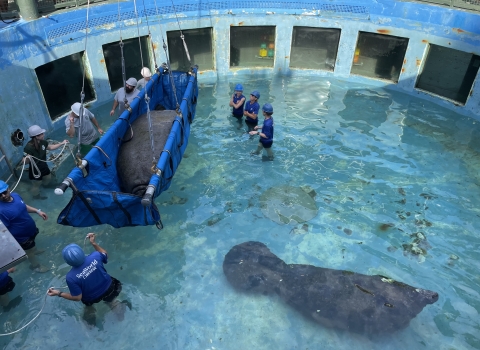This year is the 50th anniversary of the Endangered Species Act, a law that has been a powerful catalyst for conservation of America’s most treasured fish, wildlife, plants and their habitats. In the Pacific Region, our Tribes, state and federal agencies, and partners have joined with our dedicated staff to be the driving force behind the successes we share and the strength ensuring we can address the challenges ahead. Celebrate this milestone with us in this collection of stories as we reflect on past successes, assess current challenges, and envision an equally bright future for the next 50 years and beyond.
One of the furthest islands of the Northwest Hawaiian archipelago, Midway Atoll National Wildlife Refuge is no more than 2.4 miles of ground surface. Since its discovery, Midway has never been a place of simple means or purpose. The original surfaces of Midway’s two islands, Eastern and Sand, were intentionally changed to fit the needs of those living on its sands. Midway continues to change and is currently under another face lift. However, this time the change is not for the sole purpose and benefit of people, but instead, to benefit the island’s habitat and the seabirds of the Hawaiian archipelago.
What does it mean to restore a habitat? Midway’s history and landscape is a collage of human activity and disturbance. The mostly barren Sand Island whose sands and grasses hung above the surface of the water was pulled out even further from the sea. While, perhaps not literally pulled out of the sea, but layers of soil were added and the land mass enlarged. In 1903 the ship Whalen brought 400 tons of soil to Midway from Honolulu along with plants and grass seeds. Surmounting the newly shaped island was a litany of exotic plants, structures and people.
But can Midway be ecologically restored to its pre-contact habitat? Ecological restoration is defined by the Society for Ecological Restoration as the practice of assisting the recovery of an ecosystem that is damaged, degraded, or destroyed. In the case of Midway, this would also include an ecosystem that was transformed into an entirely new habitat.
In 1988, Midway Atoll became an “overlay” national wildlife refuge national wildlife refuge
A national wildlife refuge is typically a contiguous area of land and water managed by the U.S. Fish and Wildlife Service for the conservation and, where appropriate, restoration of fish, wildlife and plant resources and their habitats for the benefit of present and future generations of Americans.
Learn more about national wildlife refuge , still subject to primary jurisdiction of the Navy. However, 1993, Naval Air Facility operations came to an end. As part of the base realignment and closure process, the Navy removed over 100 underground fuel tanks and numerous structures and began the ecological restoration with island wide cleaned up.
There is no real financial or ecological feasible way to remove all the indelible impressions left behind on Midway. The island consists of a complex and layered landscape where histories merge with the land. Instead of focusing on restoring the landscape to just one definable point in history, the Service is focusing on habitat restoration that promotes native plants and protects wildlife that existed on Midway and throughout the Pacific Islands.
It starts with removing the bad and then planting the hardy. Removing invasive species invasive species
An invasive species is any plant or animal that has spread or been introduced into a new area where they are, or could, cause harm to the environment, economy, or human, animal, or plant health. Their unwelcome presence can destroy ecosystems and cost millions of dollars.
Learn more about invasive species is always an ongoing project on Midway. Invasive species take up residences quickly and in little time out-compete native plants and wildlife. And invasive species thrive in the welcoming climate of the Pacific Islands. With such an alter environment that consists with so many invasive plants, only the hardest and strongest native plants survive.
When choosing what native plants to propagate, researchers choose plants with greatest probability of survival and with the highest ecological yield for the ecosystem. In 2016, Fish and Wildlife Service personnel, volunteers and contractors undertook the largest out-planting on Midway. Some 780 pots of native bunchgrass and 300 pots of 7 other species that will help restore the habitat. With each success the habitat becomes more and more favorable for seabirds and other wildlife.
The ecological restoration of this refuge manages to keep a sense of its past while looking forward to the future. During the last 100 years, Midway has always yielded to what was best for the people living on the island with little focus on the countless native wildlife that also depends on its resources. Today, Midway is now a refuge and ecosystem that serves seabirds, shorebirds and marine mammals.
Read and learn more about Midway Atoll at:
- A Future to Count on for Albatross at Midway
- Discovering Midway’s Cultural History
- A Laysan Lovesong
- War and Peace at Midway Atoll
Ready for a tour of Midway Atoll? Discover some of Midway’s major features, monuments with “Exploring Midway Atoll” story map.
Article by Aaron Ochoa, a public affairs officer with the U.S. Fish and Wildlife Service’s Pacific Region.
###
The U.S. Fish and Wildlife Service works with others to conserve, protect, and enhance fish, wildlife, plants, and their habitats for the continuing benefit of the American people. For more information, visit www.fws.gov/pacificislands, or connect with us through any of these social media channels at https://www.facebook.com/PacificIslandsFWS, www.flickr.com/photos/usfwspacific/, https://medium.com/usfwspacificislands or www.twitter.com/USFWSPacific.




